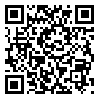Volume 35, Issue 135 (May 2022)
IJN 2022, 35(135): 94-105 |
Back to browse issues page
Download citation:
BibTeX | RIS | EndNote | Medlars | ProCite | Reference Manager | RefWorks
Send citation to:



BibTeX | RIS | EndNote | Medlars | ProCite | Reference Manager | RefWorks
Send citation to:
Moosavi S, Gholamnejad H, Hassan Shiri F, Ghofrani Kelishami F, Raoufi S. Challenges of Virtual education During the Pandemic of COVID-19: A Qualitative Research. IJN 2022; 35 (135) :94-105
URL: http://ijn.iums.ac.ir/article-1-3505-en.html
URL: http://ijn.iums.ac.ir/article-1-3505-en.html
Soolmaz Moosavi1 

 , Hanieh Gholamnejad2
, Hanieh Gholamnejad2 

 , Fatemeh Hassan Shiri3
, Fatemeh Hassan Shiri3 

 , Fatemeh Ghofrani Kelishami4
, Fatemeh Ghofrani Kelishami4 

 , Shahin Raoufi5
, Shahin Raoufi5 




 , Hanieh Gholamnejad2
, Hanieh Gholamnejad2 

 , Fatemeh Hassan Shiri3
, Fatemeh Hassan Shiri3 

 , Fatemeh Ghofrani Kelishami4
, Fatemeh Ghofrani Kelishami4 

 , Shahin Raoufi5
, Shahin Raoufi5 


1- Department of Medical Surgical Nursing, School of Nursing and Midwifery, Shahid Beheshti University of Medical Sciences, Tehran, Iran.
2- Department of Medical Surgical Nursing, School of Nursing and Midwifery, Iran University of Medical Sciences, Tehran, Iran. ,haniehgholamnejad@gmail.com
3- Department of Anesthesiology, Faculty of Paramedical Sciences, Kashan University of Medical Sciences, Kashan, Iran.
4- Department of Nursing Management, School of Nursing and Midwifery, Iran University of Medical Sciences, Tehran, Iran.
5- Department of Medical Surgical Nursing, School of Nursing and Midwifery, Lorestan University of Medical Sciences, Khorramabad, Iran.
2- Department of Medical Surgical Nursing, School of Nursing and Midwifery, Iran University of Medical Sciences, Tehran, Iran. ,
3- Department of Anesthesiology, Faculty of Paramedical Sciences, Kashan University of Medical Sciences, Kashan, Iran.
4- Department of Nursing Management, School of Nursing and Midwifery, Iran University of Medical Sciences, Tehran, Iran.
5- Department of Medical Surgical Nursing, School of Nursing and Midwifery, Lorestan University of Medical Sciences, Khorramabad, Iran.
Abstract: (5702 Views)
Background & Aims: Coronavirus epidemic, along with other countries around the world, in Iran, also raised the need for social distancing and home quarantine. As a result, the continuation of face-to-face education was disrupted and virtual education was chosen as a strategy for not stopping education in schools and universities. Alternatively, virtual education was adopted in order not to stop education, thereby causing new challenges for students and universities. This qualitative study aimed at investigating the experiences of university professors of the problems of virtual education during the COVID-19 pandemic.
Materials & Methods: This qualitative study was conducted using conventional content analysis. The aim of this study was to answer the question “What is the experience of university teachers about the challenges of virtual education during covid-19 pandemic?”. Participants were 24 university teachers in different fields whom were selected with purposeful sampling. Teachers of different disciplines at the university with a master’s degree or higher who also had at least three years of teaching experience were included in the study. Semi-structured interviews with open-ended questions were used to collect data. Analyzing data was done through conventional content analysis with Lundman and Graneheim methods with Maxqda.
Results: The descriptive results of the study revealed that the age range of the participants was from 30 to 50 years old. 62.5 percent of the teachers were female. Their teaching experience varied from 3 to 26 years. In terms of academic degree, 58 percent were assistant professor, 20 percent were instructor, 16 percent were associate professor, and 6 percent were full professor. Additionally, 66 percent of them were teaching at state universities. The results obtained from the qualitative part of the study included Technology-related problems with 3 subcategory, Problems with the teaching process with 5 subcategory and Poor interaction with 3 subcategory.
Conclusion: Due to the long closure of universities and the long-term use of e-learning Managers and policymakers in the education system need to design programs to address these issues.
Materials & Methods: This qualitative study was conducted using conventional content analysis. The aim of this study was to answer the question “What is the experience of university teachers about the challenges of virtual education during covid-19 pandemic?”. Participants were 24 university teachers in different fields whom were selected with purposeful sampling. Teachers of different disciplines at the university with a master’s degree or higher who also had at least three years of teaching experience were included in the study. Semi-structured interviews with open-ended questions were used to collect data. Analyzing data was done through conventional content analysis with Lundman and Graneheim methods with Maxqda.
Results: The descriptive results of the study revealed that the age range of the participants was from 30 to 50 years old. 62.5 percent of the teachers were female. Their teaching experience varied from 3 to 26 years. In terms of academic degree, 58 percent were assistant professor, 20 percent were instructor, 16 percent were associate professor, and 6 percent were full professor. Additionally, 66 percent of them were teaching at state universities. The results obtained from the qualitative part of the study included Technology-related problems with 3 subcategory, Problems with the teaching process with 5 subcategory and Poor interaction with 3 subcategory.
Conclusion: Due to the long closure of universities and the long-term use of e-learning Managers and policymakers in the education system need to design programs to address these issues.
Type of Study: کیفی |
Subject:
nursing
Received: 2021/11/24 | Accepted: 2022/04/21 | Published: 2022/05/1
Received: 2021/11/24 | Accepted: 2022/04/21 | Published: 2022/05/1
Send email to the article author
| Rights and permissions | |
 |
This work is licensed under a Creative Commons Attribution-NonCommercial 4.0 International License. |




